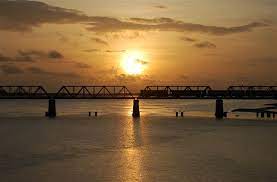The climate of Karnataka is influenced by its geographical location, diverse topography, and the influence of the Arabian Sea and the Bay of Bengal. The state experiences a varied climate with distinct seasons.

Tropical Monsoon Climate
-
- Karnataka’s climate is characterized as a tropical monsoon climate, which is typical of most regions in southern India.
- The state experiences a clear division between the wet and dry seasons, influenced by the seasonal monsoon winds.
Summer (March to May)
-
- Summers in Karnataka are hot and dry, with temperatures ranging from 30°C to 40°C (86°F to 104°F) in most parts of the state.
- The temperatures are higher in the northern regions of Karnataka, such as Bellary and Gulbarga, compared to the coastal and southwestern regions.
Monsoon (June to September)
-
- The southwest monsoon, originating from the Arabian Sea, brings heavy rainfall to Karnataka during the months of June to September.
- The coastal areas, including cities like Mangalore, receive significant rainfall during this season, contributing to the lush greenery and agricultural productivity.
- The northern regions, like Bidar and Raichur, receive comparatively lower rainfall during the monsoon.
Post-Monsoon (October to November)
-
- After the monsoon season, Karnataka experiences a transitional period known as the post-monsoon season.
- During this time, the rainfall decreases, and the weather becomes more pleasant.
Winter (December to February)
-
- Winters in Karnataka are mild and pleasant, with temperatures ranging from 15°C to 30°C (59°F to 86°F) during the day.
- The nights can get relatively cooler, especially in the northern regions and the hill stations like Coorg and Chikmagalur.
Karnataka’s climate is also influenced by its diverse topography, which includes coastal areas, plains, hills, and plateaus. The Western Ghats in the western part of the state receive heavy rainfall, making them ecologically rich and supporting several important rivers.
The climate of Karnataka plays a significant role in shaping the state’s economy, particularly agriculture, as it is one of the major contributors to the state’s GDP. The varied climate also makes Karnataka a popular destination for tourism, offering visitors diverse experiences ranging from coastal beaches to scenic hill stations.
According to the Koppen climate classification scheme. Karnataka’s climate can be broadly categorized into two main climate types: Tropical Monsoon Climate (Am) and Tropical Savanna Climate (Aw).
Tropical Monsoon Climate (Am):
-
- This climate type is prevalent in most parts of Karnataka, including coastal areas and regions in the Western Ghats.
- The Am climate is characterized by high temperatures throughout the year and distinct wet and dry seasons.
- Summers in Karnataka (March to May) are hot and dry, with temperatures ranging from 30°C to 40°C (86°F to 104°F) in most parts of the state.
- The monsoon season (June to September) brings heavy rainfall to the region, with coastal areas, such as Mangalore, receiving significant precipitation.
- Winters (December to February) are mild and pleasant, with temperatures ranging from 15°C to 30°C (59°F to 86°F) during the day.
Tropical Savanna Climate (Aw)
-
- The Aw climate is found in certain inland regions of Karnataka, particularly in the northern parts of the state, including cities like Bellary and Gulbarga.
- This climate type shares similarities with the Am climate, with hot and dry summers and a distinct wet and dry season.
- Summers in the Aw region are extremely hot, with temperatures often exceeding 40°C (104°F) and sometimes reaching up to 45°C (113°F) or more.
- The monsoon season brings some rainfall to these areas, but it is generally lower compared to the coastal and Western Ghats regions.
- Winters are relatively cooler than summers, with temperatures ranging from 15°C to 30°C (59°F to 86°F) during the day.
Karnataka’s climate is influenced by its geographical location, diverse topography, and the impact of the Arabian Sea and the Bay of Bengal. The Western Ghats in the western part of the state significantly influence rainfall patterns, contributing to the Am climate in those regions. The northern regions and inland areas, which experience the Aw climate, have lower rainfall and higher temperatures during summers.
The climate of Karnataka plays a crucial role in shaping the state’s agriculture, economy, and overall way of life for its residents. The varied climate also makes Karnataka a popular destination for tourism, offering visitors diverse experiences ranging from coastal beaches to scenic hill stations, wildlife sanctuaries, and historic monuments.
Important Links